Writing is already hard enough, but writing with the goal of ranking in Google requires even more strategic planning.
Successful SEO copywriters consider what users want, and how search engines actually work, throughout their writing process.
For those site owners who want to grow their visibility through content, understanding SEO copywriting is the right place to start.
What Is SEO Copywriting?
SEO copywriting is the process of creating content with the goal of ranking in search engines for relevant keywords.
The process can be applied to your homepage, product pages, blog posts, or even your profiles on review sites.
When done well, SEO copywriting can increase the total number of keywords that your content ranks for.
Why Does SEO Copywriting Matter To Ranking?
Google relies on natural language processing to understand what users are searching for and what our content is about.
Over the years, NLP models have gotten far more advanced.
If you want to learn more about NLP technology, put some of your own website content into Google’s Natural Language API Demo.
Then, see how Google works to understand it.
-
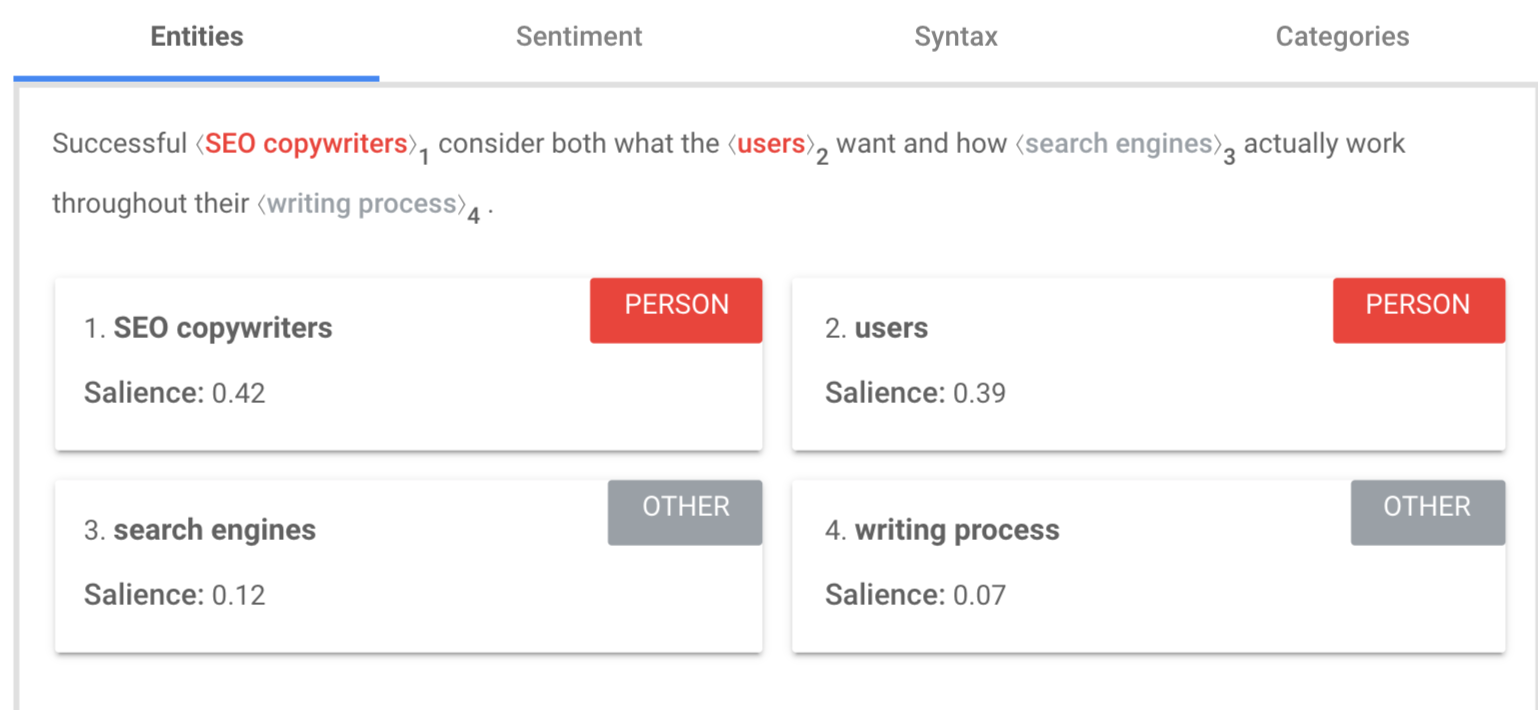 Screenshot from Google’s Natural Language Processing API Demo Tool, December 2021
Screenshot from Google’s Natural Language Processing API Demo Tool, December 2021
-
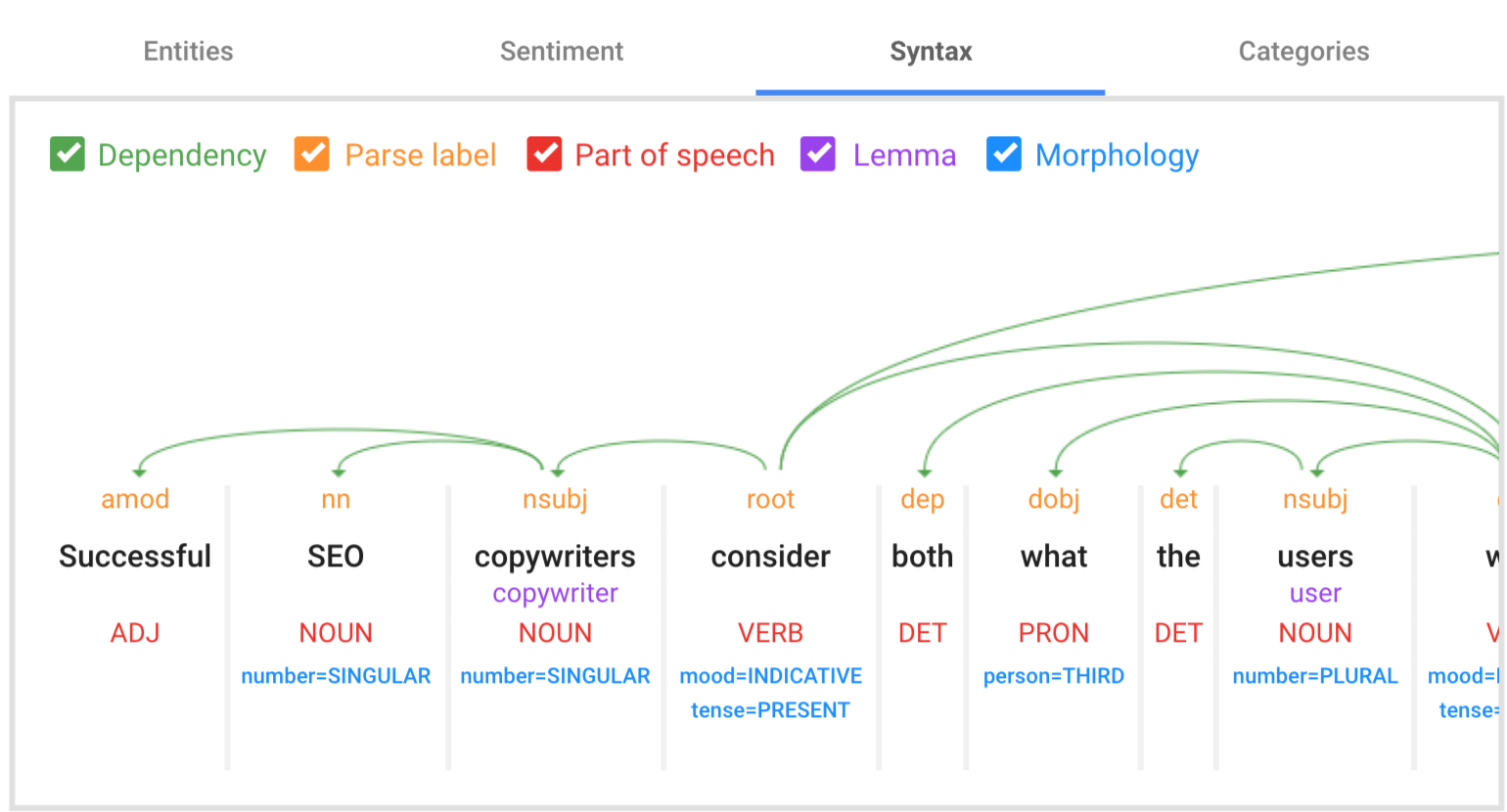 Screenshot from Google’s Natural Language Processing API Demo Tool, December 2021
Screenshot from Google’s Natural Language Processing API Demo Tool, December 2021
Because of Google’s advancements in NLP, SEO copywriting has evolved to be far less about quick tricks and far more about creating informative and valuable content for users.
But as seen above, Google is still a robot.
SEO copywriters should consider how search engine technology actually works and leverage that knowledge when writing their content.
SEO Copywriting Tips For Better Rankings
The best content will always be created with users in mind.
But, there are strategic choices copywriters can make to help crawlers better understand their content and promote it accordingly.
Here are some SEO copywriting tips for creating content that is loved by both users and search engines alike.
Research And Prewriting
1. Choose A Realistic Keyword Goal
Before you start writing, you should have a clear keyword target in mind. But make sure you set your content up for success by setting realistic and achievable keyword goals.
Keyword research is the foundation of the SEO copywriting process.
You might be tempted to choose industry keywords that have higher search volume, but those keywords are often extremely competitive.
If you are a website with less authority, you’re unlikely to rank on page one for those terms, no matter how high-quality your content is.
So how do you know if your content stands a chance of ranking?
Keyword difficulty scores can serve as a benchmark for your keyword goals.
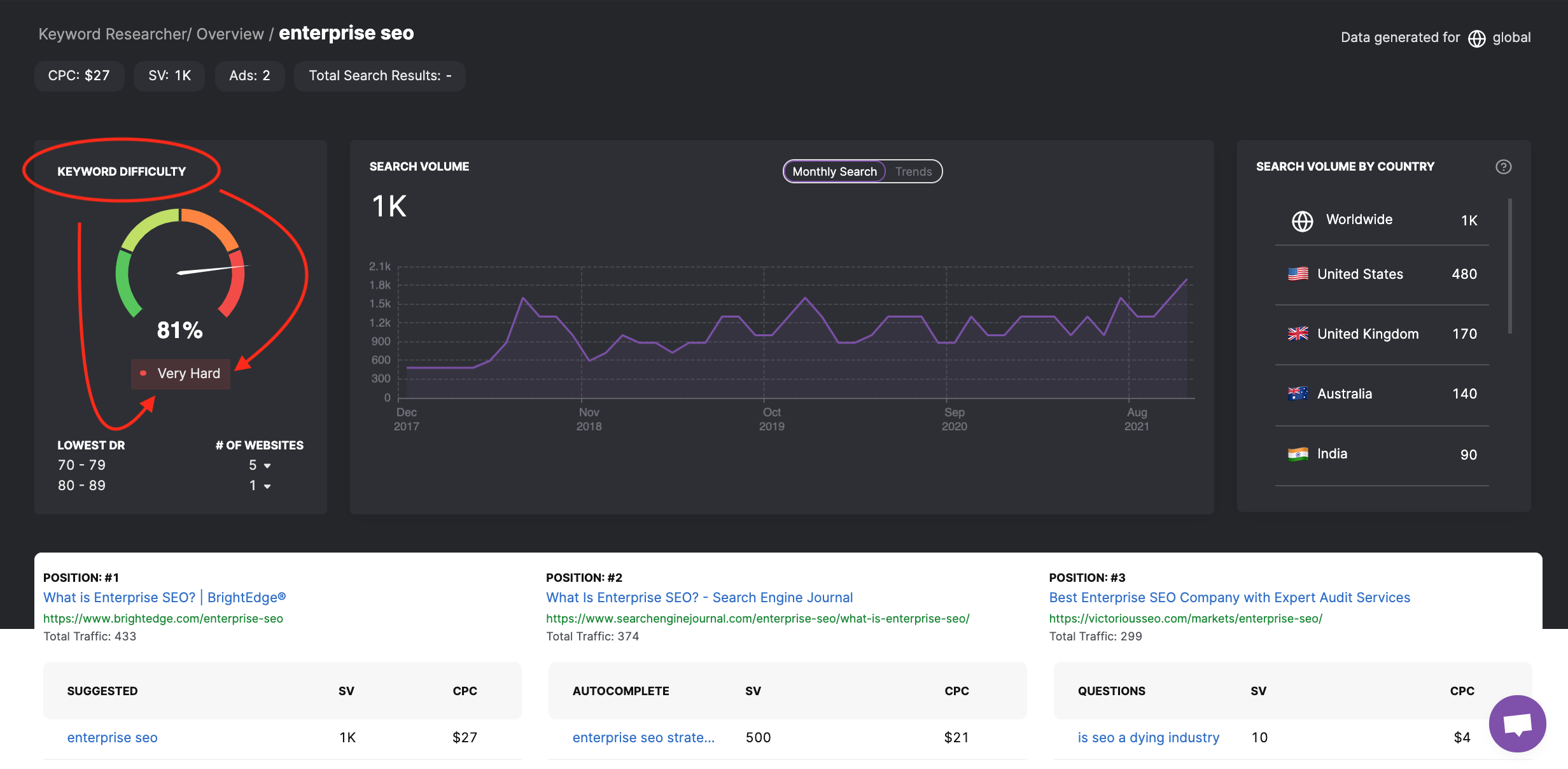 Screenshot from SearchAtlas, December 2021
Screenshot from SearchAtlas, December 2021-
 Screenshot from Ahrefs, December 2021
Screenshot from Ahrefs, December 2021
I suggest finding relevant keywords with difficulty scores that are less than or equal to your site’s DA.
These keywords might be long-tail or have more informational search intent, but they can present real opportunities for your content to rank quickly and start driving clicks.
2. Analyze The Top-Ranking Content
Want to know what it will take to rank? Look at the content that is already on page one.
Review the top-ranking pieces of content and use them as models for your own content creation.
How long is the content? What are the page titles and meta descriptions that are enticing the users to click?
-
 Screenshot from SearchAtlas, December 2021
Screenshot from SearchAtlas, December 2021
The goal here is not to create a carbon copy of your competitors, but to better understand what content, authority, and page experience signals that Google crawlers are responding to.
3. Understand And Write For Search Intent
Search intent is often narrowed down into four categories: Navigational, Informational, Transactional, and Commercial.
The search intent of your target keyword determines what type of content you should create.
For transactional keywords, Google is more likely to promote product or service pages knowing that the user wants to make a purchase.
For informational queries, Google more often ranks blogs, top-ten lists, how-to articles, and resource-driven content types.
Most likely, your keyword can be categorized in the above four categories, so strive to meet that intent with your content.
4. Outline Your Structure
Not all content outlines will look exactly alike, but the idea is to determine the overall topic, subtopics, headings, and main points the content will include.
If you’re optimizing properly, your keyword targets will have a prominent place in these structural components.
Not all copywriters like to work from outlines, but they can be very useful in ensuring proper on-page SEO practices.
5. Prioritize Quality Over Everything Else
Google wants to rank quality content for its users.
But what is quality in the eyes of crawlers? Relevance, load times, backlinks, and referring domains, to name just a few.
In terms of the quality signals that are communicated through the writing, Google is looking for:
- Comprehensive, in-depth content.
- Original reporting and analysis.
- Expert authorship and sourcing.
- Proper grammar and spelling.
Do your best to meet these signals, and Google is more likely to see your website as high-quality.
The SEO Copywriting Process
6. Explore Your Topic In-depth
Although content length is not a ranking factor, there is a strong correlation between longer content and top rankings.
That’s because long content is more likely to display the quality signals listed in tip #5. Additional studies have shown that longer content also earns more backlinks and social engagements.
So do your best to be comprehensive and explore your content in-depth.
Keyword tools can help you expand on your content by showing you the subtopics that have a relationship to your keyword goal.
7. Write For Passage Ranking
Google’s Passage Ranking update went live in early 2021. As a result, Google no longer just indexes and ranks web pages, but specific passages of content.
For example, the below content provides a thorough answer to the search query, [What is an SEO assistant?].
When the user clicks on the SERP result, Google has indexed the exact part of the web page that answers that question and highlights it for users.
-
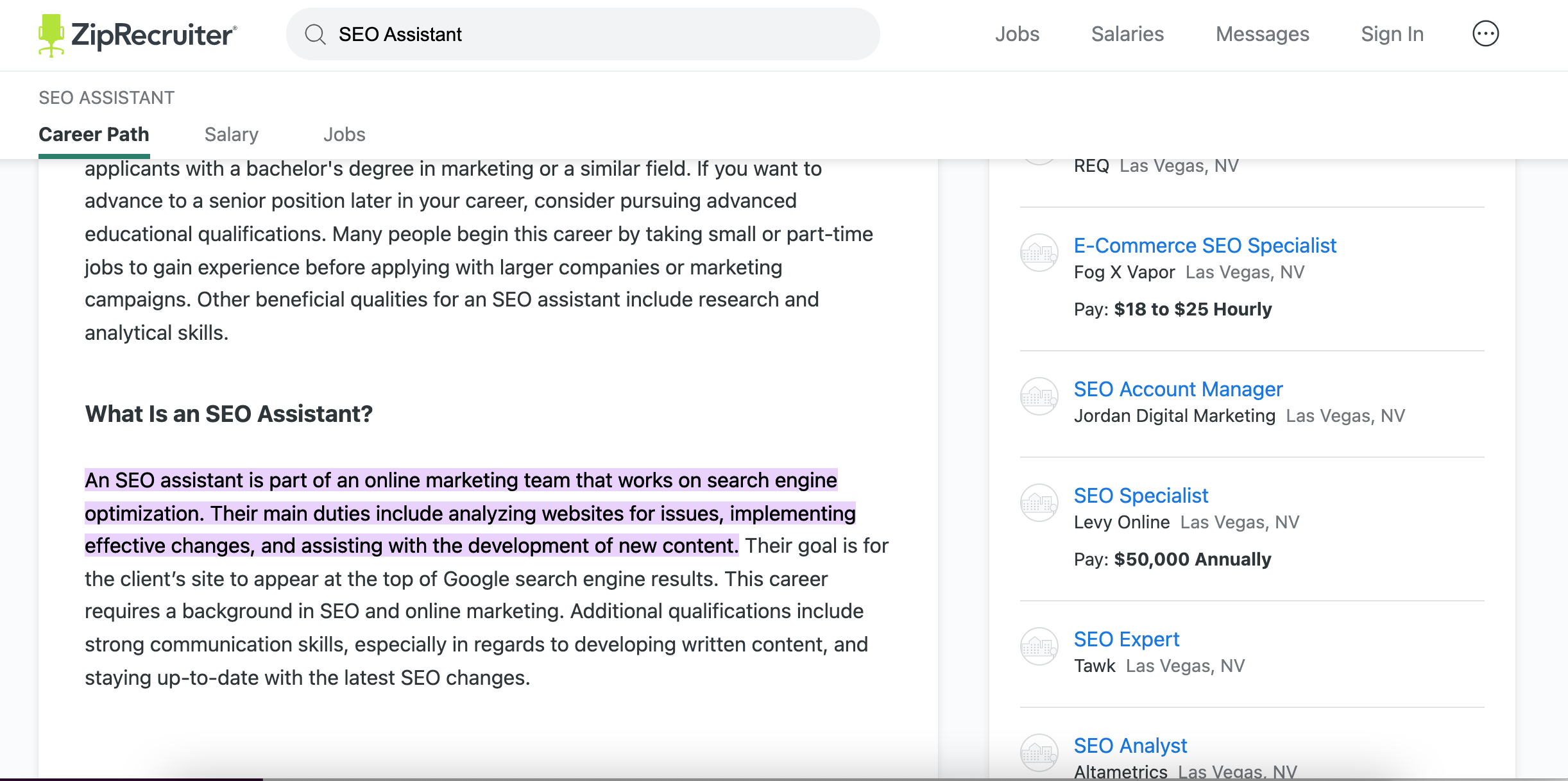 Screenshot from ZipRecruiter, December 2021
Screenshot from ZipRecruiter, December 2021
Passage Ranking means that your content has so many opportunities to rank for multiple queries.
Strategic use of structure, headlines, and questions is key to helping passages of your content rank well in search.
8. Use A Content Optimization Tool
Leveraging AI and NLP tools can result in major boosts in keyword rankings.
Clearscope, SearchAtlas, SEMrush, and others all have content optimization software that eliminates some of the guesswork of the SEO copywriting process.
These tools identify common words and topics used in top-ranking content and suggest similar terms for you to include in yours. As long as you incorporate them naturally, the results can be significant.
-
 Screenshot of Google Search Console, December 2021
Screenshot of Google Search Console, December 2021
I’ve seen content tools have an almost immediate impact on the total number of keywords, impressions, and average positions that web pages earn.
More SEO copywriters should be using them.
9. Offer Answers To Related Questions
Another way to improve keyword rankings is to answer common questions that users are asking in relation to your target keyword.
There are a couple of ways you can find out what these questions are: Google Search and a keyword tool.
Look to People Also Ask and autocomplete to see what common questions people are asking about the topic. Then, make sure you include those questions and their answers in your content.
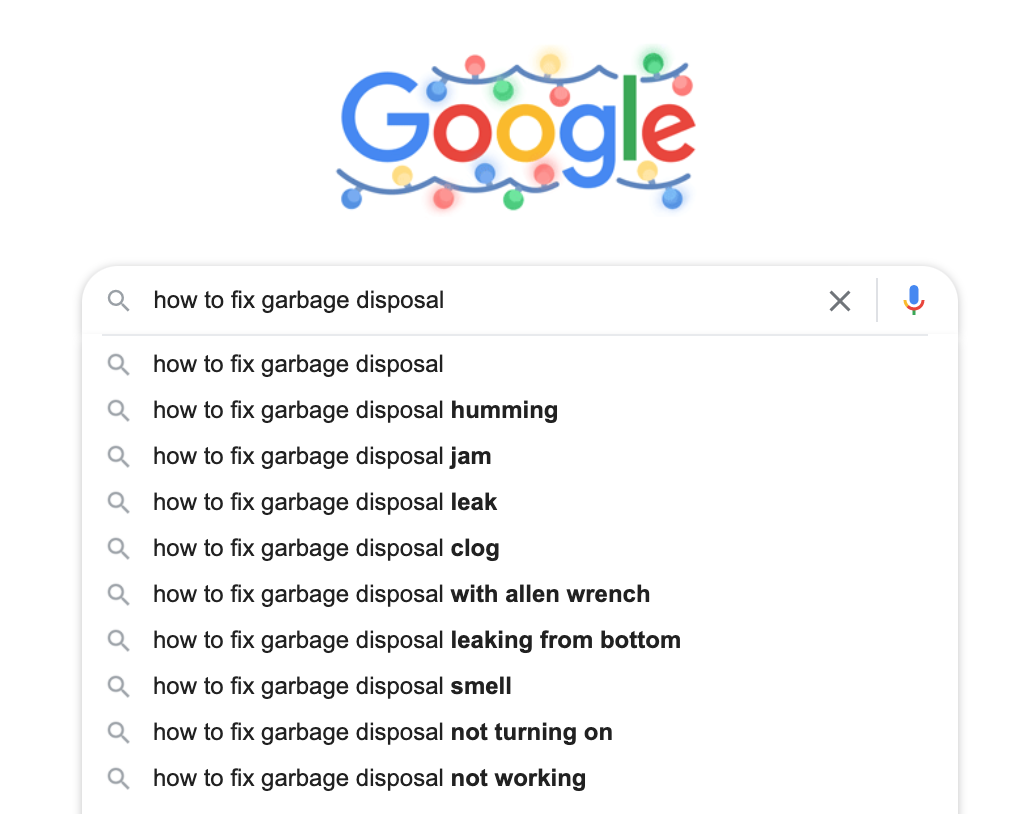 Screenshot from search for [how to fix garbage disposal], Google, December 2021
Screenshot from search for [how to fix garbage disposal], Google, December 2021
Similarly, some keyword tools can tell you the common questions that searchers are asking.
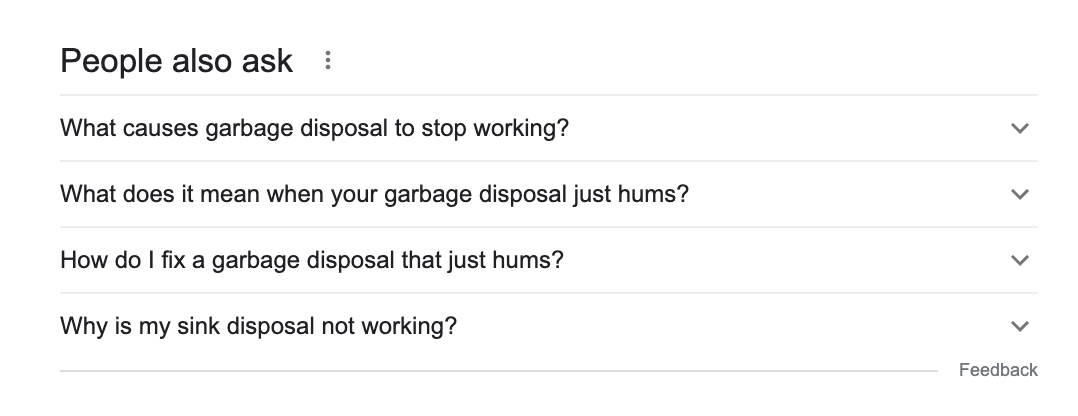 Screenshot from search for [how to fix garbage disposal], Google, December 2021
Screenshot from search for [how to fix garbage disposal], Google, December 2021
10. Include Synonyms And Keywords In Your Headings
It’s important to include your keywords in your h1s and h2s, but Google is now smart enough to understand synonyms and other related terms.
Choose words that have a semantic relationship with your primary keyword target.
Google’s NLP algorithms use them to understand your content more deeply.
Adding these terms into your headings can help you signal strong relevance but without keyword stuffing.
11. Avoid Long Sentences, Long Paragraphs, And Misspellings
In terms of readability, you want your content to be easily understood by a variety of people. If your content is too academic or technical, some may choose to bounce back to the SERPs.
Similarly, content that is poorly written or full of typos will deter readers.
Aim for shorter sentences and paragraphs to improve the reading experience.
Some SEO tools suggest a grade level, but the idea is to keep the language simple and accessible to as many people as possible.
Copywriting Extras
12. Break Up Your Content With Rich Media
Although long-form text is important to ranking, your content should have other non-textual elements that help readers stay engaged.
Make sure you include images, videos, or infographics in your content, particularly to break up long passages of text.
Google likes to see content that incorporates rich media, so leverage it to your advantage.
If that rich media slows down the performance of your pages though, it can work against you. So make sure any rich media is optimized for speed and performance.
13. Include Relevant Links With Contextual Anchor Text
Your internal and external links, as well as the anchor text of those links, are also important quality signals to Google.
Make sure you link to relevant, authoritative sources. Also, make sure you utilize anchor text best practices:
- Anchor text should be relevant to the destination page.
- Don’t use too much exact match anchor text.
- Avoid generic anchor text (e.g. “click here”).
- Use contextual anchor text as often as possible.
14. Make Your Content Easy To Navigate
Features like a table of contents and jumplinks make your content more user-friendly.
This is particularly true for longer articles or resource pages.
-
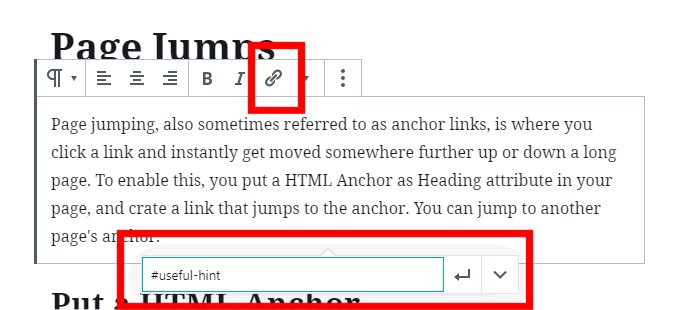 Screenshot from WordPress, December 2021
Screenshot from WordPress, December 2021
Google crawlers like to see these navigational elements on the page that improve UX. Make sure you incorporate them whenever you can.
After The Writing
15. Make Sure That Google Understands Your Content
A week or so after you publish your content, login into your Google Search Console account to confirm that Google is understanding it correctly.
See what keywords you are earning impressions for.
If they are close to or relevant to your original keyword goal, great. If not, you may need to revise the content.
Higher positions and clicks will come with time and authority building, but impressions are a good early sign that Google understands your content and knows when to promote it.
16. Optimize And Test Your Meta Tags
Google now rewrites page titles and meta descriptions when it sees fit, but this only happens about 20% of the time.
It is still important to write optimized meta tags so Google understands your content and users are enticed to click.
However, you don’t have to take a one-and-done approach to meta tag optimization.
If after several months, your content gets to page one but still has a low click-through rate, test out page titles and meta descriptions to see which produce the best results.
17. Revise And Update Accordingly
Over time, your content will eventually become outdated.
New information may become available, keywords may grow more competitive, links may break, and more.
So make sure to revisit old or underperforming content to see if more attention is needed.
Your most important content assets should be updated at least once a year, particularly if they are discussing industry trends or analysis.
Final Thoughts On SEO Copywriting
The reality is, SEO copywriting doesn’t end after the content is published on your website.
The internet changes, algorithms evolve, and your content needs to be updated accordingly.
If you deploy this final tip, you can increase the shelf-life of your content so it maintains top keyword rankings for years to come.
More resources:
- SEO Copywriting: The Complete Guide
- SEO Content Writing vs. SEO Copywriting: What’s the Difference?
- Content Marketing KPIs: Your Guide to Picking the Right KPIs for Content
Featured Image: WarmWorld/Shutterstock





